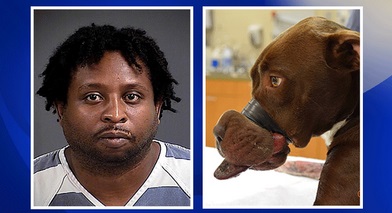Animal Cruelty: Are the Newest Punishments Enough?

The most recent disturbing case here in Utah that gained national notoriety was in Saratoga Springs where Jordan Lindquist, a house guest of Colleen Cloward and her son, Kaleb, was arrested in April and charged with felony animal cruelty charges after being caught on a nanny cam severely abusing Colleen’s cat. The video shows Lindquist pulling the cat out from under the bed, throwing it on the bed and hitting the animal with extreme force directly in the head numerous times. The video also shows the cat being shaken and slammed to the ground.

And just when you think it can’t get more disturbing than that, a horrific case of abuse recently came out of North Charleston, S.C. Police on Friday arrested William Leonard Dodson for taping a 15-month-old Staffordshire mix puppy’s muzzle shut. The story of Caitlin quickly spread around the nation causing a mass of outrage and plenty of volunteers offering rewards to capture her abuser.
It has often been said that those that have no regard for harming or causing pain to an animal would be more likely be act same towards humans. “We need to recognize that animals need to be treated with decency and respect,” said John Goodwin, director of animal cruelty and policies for the Humane Society of the U.S.
He also stated that there is a direct correlation between domestic violence and animal abuse and there are currently two bills in the U.S. Congress and many others headed that way to help protect the animals that are continuing to be hurt by these abusers. “Currently 50 percent of the states have the ability to add their pets to protective orders for those involved in domestic violence cases,” said Goodwin.
Rep. Katherine M. Clark (D-MA) introduced the Pet and Women Safety Act of 2014 to The House last July. It requires that states encourage the inclusion of protections against violent or threatening acts against the pet of the person in domestic violence protection orders on a federal level. It is meant to protect the pet should their owner move out of a state that has a protective order in place to a state that doesn’t have the same law. In September the bill was passed to the sub-committee on crime, terrorism, homeland security, and investigations for further review.
In 2013, the last of the 50 states passed the ability to charge someone with felony animal cruelty and in 2014 the FBI decided to start including animal abuse case statistics to its national reporting database. “We are making great strides and there are a lot more cases gaining national attention because of it,” said Goodwin. “I do not believe that we have enough data behind us just yet to determine if the stricter punishments will deter anyone from abuse of animals but we are very pleased with where the movement has taken us.”
Temma Martin, public relations specialist for Best Friends Animal Society said it’s important to know local laws to recognize when an animal is being abused or neglected. “Sometimes abuse is obvious, like tape on a dog’s muzzle that prevents him from eating, drinking and panting normally. Physical violence is clear abuse, even when someone tries to disguise it as obedience training,” said Martin.
Martin further states it is often other kinds of abuse that is harder to see. “Neglect can take more subtle forms, like failing to provide adequate food, water, shelter from the elements and medical care, all of which are required by Utah law. Other types of neglect include dogs that are chained for long periods of time, especially out of reach of their food, water and protection from extreme weather.”
While there are federal laws being worked on to help curve the disturbing rituals of animal abuse, it is the state and local laws that some hope will make a difference. Martin reminds us that the most important thing people can to do is be aware of abuse and neglect in all of its forms and report it immediately if they suspect an animal is being harmed or mistreated. She said it’s also helpful to document the abuse or neglect with photos or video if this can be done safely. Abuse should be reported to the local police department or animal control agency in your area.
As pet owners there are plenty of things we can do to help. “Pet owners should make good decisions to keep their animal safe and prevent them from becoming a nuisance to others in the community and pets should be kept safely confined to the home and yard, and on a leash when off their property.” said Martin.
She also suggests spaying and neutering pets so that it reduces many undesirable behaviors, such as roaming, biting, fighting and marking. “Dogs should be trained, socialized, exercised and kept inside the home as much as possible and treated as part of the family. Dogs are social animals, and left outside alone all the time they become bored and lonely and often bark incessantly. Some of the many cases of dogs’ mouths being taped shut allegedly resulted from claims that the dogs barked too much.”






